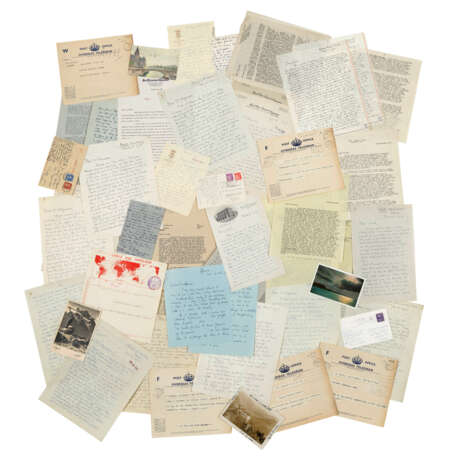ID 1109008
Lot 208 | Ernest Bloch (1880-1959)
Estimate value
£ 8 000 – 12 000
An important correspondence with Ernest Chapman, 1933-1958
Comprising c.120 autograph and typed letters signed to Ernest Chapman, many with his replies, San Francisco, Paris, Châtel, Geneva, Naples, New York, Rangeley (Maine), North Platte (Nebraska), Agate Beach (Oregon) and elsewhere in America, 21 September 1933 to 17 August 1958
In English. c. 345 pages, various sizes, some on postcards, telegrams or greetings cards. [With:] 12 letters to Chapman from Bloch's wife, Marguerite [And:] typescript of ‘Ernest Bloch at 75’ (published in Tempo) by Ernest Chapman, with autograph comments and corrections in Bloch's hand. Provenance: Sotheby's, 27 November 1980, lot 216.
An important correspondence between Ernest Bloch and Ernest Chapman, an indispensable source for the musical career, opinions, methods and personal life of the great Swiss composer, a singular figure in the music of the 20th century. The correspondence presents – except for a period of three years during WWII – a continuous picture of the last twenty-five years of Ernest Bloch's life, from 1933 until a few months before his death. Throughout this period Bloch was actively composing, continuing even during his long last illness until a few weeks before his death. Among the subjects covered are the gestation and creation of new works, including such important compositions as the Violin Concerto (recorded by Szigeti, Menuhin, Totenberg, Bress, etc), the 'Avodath Hakodesh' (or ‘Sacred Service’, recorded by Bloch and Bernstein), the 'Voice in the Wilderness' for cello and orchestra, the Concerto Symphonique for piano and orchestra, the Piano Sonata, the final Suites for unaccompanied stringed instruments (shortly to be recorded by Menuhin) and other works, including the difficulties in bringing his opera, Macbeth, to premiere 30 years after it was written, with the last-minute resignation of the conductor and Bloch’s illness; his conducting activities with leading orchestras in Europe and the United States; and his composition teaching courses at the University of California. In some letters he discusses the origin of his Jewish national style, and how he came to regard this in later years, and his artistic and philosophical outlook as a whole; some contain references to his personal life, and his view of his life as ‘a tragedy’, and his opinions on contemporaries such as Schoenberg and Stravinsky. He expounds upon his method of teaching composition, with many references to his extremely detailed analyses of Beethoven's 'Eroica’, fugues by Bach, works by Lassus (‘incomparable’), Josquin de Pres (‘no less extraordinary – more daring’), Palestrina and others; expressing his concern that his huge collection of pedagogical material should be properly edited and published.
During their twenty-five year relationship Bloch regarded Ernest Chapman first as a young admirer of his music, then as his publisher (at Boosey & Hawkes) and friend, and eventually as a confidant to whom he wrote with ever increasing frankness about himself, his music and the world at large. Some of the letters are – intentionally – extremely self-revealing. The correspondence as a whole constitutes a unique and indispensable source of information about Bloch's activities and thinking during the period of his full maturity as both man and artist. Bloch was a highly articulate writer, eager to convey all his news and views. His letters reveal a man of deep culture, wide ranging interests and passionate feelings. His prose is concise and clear, always lively and often extremely vivid. Ernest Chapman's replies are in a cooler, more factual style, making an appropriate foil.
Chronological index of the correspondence available on request.
| Place of origin: | Switzerland, USA |
|---|
| Place of origin: | Switzerland, USA |
|---|
| Address of auction |
CHRISTIE'S 8 King Street, St. James's SW1Y 6QT London United Kingdom | |||||
|---|---|---|---|---|---|---|
| Preview |
| |||||
| Phone | +44 (0)20 7839 9060 | |||||
| Buyer Premium | see on Website | |||||
| Conditions of purchase | Conditions of purchase |



